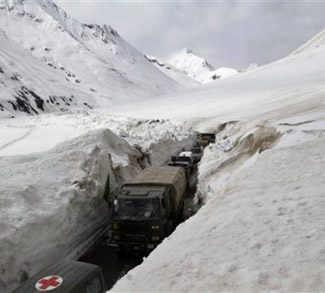In a move that may rattle India’s neighbours, the Indian Air Force (IAF) has decided to convert the Kargil airstrip into a full-fledged air force base by 2016. The strip lies close to the Line of Control (LoC) with Pakistan. The IAF is planning to operate medium, heavy-lift and combat aircrafts from Kargil in the near future.
The Kargil War of 1999 saw significant shelling and damage to the airstrip, and converting the airport into a full-fledged air base seems to be a logical response to those loses.
The upgrade of the advanced landing ground (ALG) in Nyoma is also in the pipeline. It is situated in the Leh district of the Ladakh region. The compact airstrip at Nyoma is only 23kms from Line of Actual Control (LAC) with China. The expansion plan is part of a series of airfield modernization projects taken up since the government revised its policy and began upgrading infrastructure along the border. The plan of having an air base in Kargil, which shares a border with Pakistan and China can be interpreted as an effort to address the threat posed by both countries simultaneously, and is hence of great strategic significance to India.
The upgrade of the airstrip by the IAF is meant to strengthen its capabilities in Ladakh. It can be seen as a step to shore up its offensive and defensive capabilities and operate all types of aircrafts along the border with Pakistan and China in the north and northeastern regions of Jammu and Kashmir. India’s military establishment has watched rapid development in Tibet through the construction of roads, airfields, bridges and railways by the Chinese government and airstrip upgrades can be seen as a response to these Chinese actions.
The Chinese intrusion along the border area of Ladakh can be seen as another factor, which led to the decision to convert the airstrip into a full-fledged air base. In August 2011, two Chinese helicopters, each with around eight troopers on board, flew into Indian territory along the LAC in Chumur area of the Ladakh region. This was not the first time that Chinese choppers entered Indian territory. On June 21, 2009, two Chinese choppers reportedly intruded into Chumur, following which military patrolling in the area was stepped up by the Army. The development of a full-fledged air base in Kargil will act as a deterrent to future intrusions and attacks by immediate neighbours.
The extreme forward location of this base makes its strategic and operational value extremely dubious, not to mention that it ignores several central tenets of air warfare. It is particularly of note that this airstrip is within the shelling range of Pakistani guns and the stationing of multimillion dollar aircrafts within the range of Pakistani artillery raises questions about the strategic planning of the air force. Moreover, the wisdom of stationing aircrafts at such height, thereby reducing both their range and payload, removes a significant air power advantage that India has over China – the Chinese airfields close to the border are all at high altitudes, whereas India has the advantage of the Indo-Gangetic bases at significantly lower altitudes.
This airbase can be viewed as being tactically and strategically inutile. This is due to the fact that significant resources will be expended to eliminate the threat at the very onset of hostilities. Its proximity to the border, and the ability of planes to weave their way through the mountains and evade Indian Airborne Warning and Control System (AWACS) leave it with little scope for any early warning. India’s decision to squander air power advantages in response to Chinese infrastructural activity and border provocations betrays a sense of panic and paranoia within the Indian Air Force.
Some sectors in Jammu and Kashmir see it as a move towards increasing the militarization process in the state. However, it is more likely meant to act as a deterrent to the Pakistani and Chinese threats. Moreover, for the people of Kargil, it carries the added benefit of possible employment opportunities in the aviation sector.




